No products in the cart.
Camel Trekking in Mongolia’s Gobi
Camel Trekking in Mongolia’s Gobi – A Custom Trip for Repeat Riding Guests

In May 2018 we embarked on a special adventure, tailored to two guests who the previous year had taken part in our autumn horse riding tour in Gorkhi Terelj National Park. This custom tour of camel trekking in Mongolia’s Gobi was carefully prepared. The route was scouted out by our local support staff in the South Gobi, choosing a trekking trail that would lead us into great mountain scenery, over passes and through winding gorges, until we left the mountain range again for the final days of riding in wide open desert plains.
This tour of camel trekking in Mongolia’s Gobi was a true expedition, with pack camels carrying all our supplies, and our little caravan camping along the way. We set out with ten camels, seven riding camels and three pack camels. The seven riders on camel back included our two guests, two camel guides, our local logistics support, and two of our Stone Horse Expeditions team. The two camel guides were from local herder families, and the owners of the trekking camels.
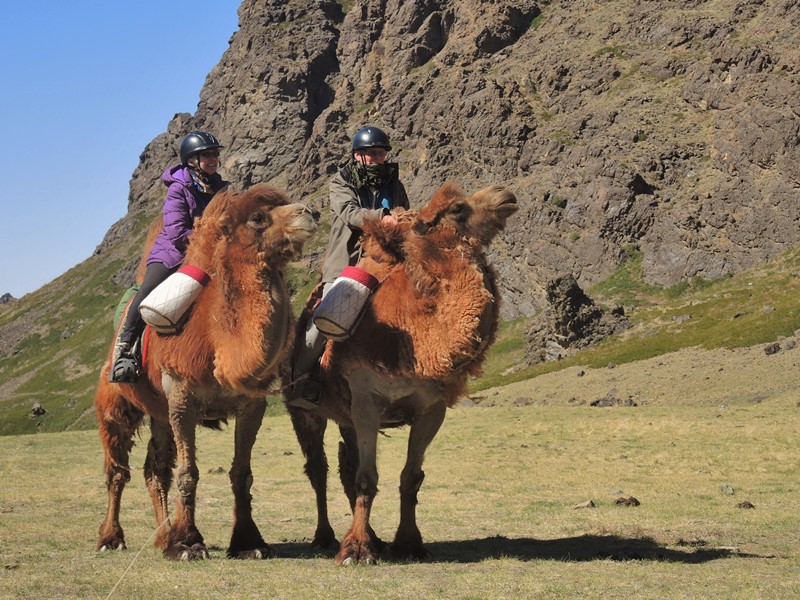
Trekking in the Gobi Weather
Travel in Mongolia’s Gobi is always an adventure, with good chances of spotting wildlife, traversing amazing landscapes, – and facing a climate that can
be challenging. The Gobi is the coldest desert on earth, and temperature differences between the summer and winter extremes are significant. In January, the average temperature in the South Gobi is about – 15 Centigrades (about 6 degrees Fahrenheit) and in the hottest months, in July, the average is around 21 Centigrades (or 70 degrees Fahrenheit)[1].
These are averages, and there can be very hot summer days, way above 30 Centigrades and into the 40ies (into the 90ies Fahrenheit and above 100), and very cold winter days, below – 20 Centigrades (below – 4 Fahrenheit.) May is usually of moderate temperatures, and a nice month to travel, but there is a range of weather to reckon with. More than temperature extremes, it is high wind speeds that are the greatest challenge for Gobi travelers. And while last May we had fairly nice temperatures, cool but not too cold, the winds were quite relentless. There were, however, also several days of calm, with beautiful sunshine.
Higher winds during camel trekking in Mongolia’s Gobi are not even such a problem when riding, but for camping they are the main challenge. We had to seek shelter from the winds when making camp, and on the last day had to choose a different camp site than planned. Rather than in the foothills of the Western Beauty Mountains, we went lower and found a site protected by a small escarpment above a river bed.
Desert Camping
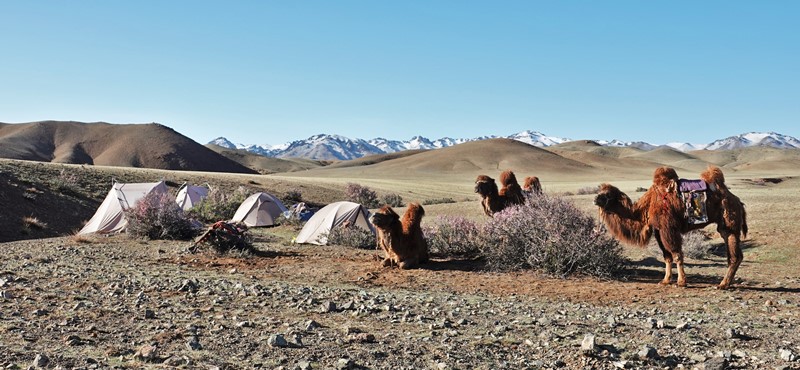
An important criterion for a campsite of course is availability of water, more often a well than a natural spring or creek in the Gobi. The campsite of our last night had no such water source, but thanks to our Gobi support staff and the fact she is well known and respected in her local community, we soon had a great supply of water. Duya flagged down a local herder passing by on his motorbike, and shortly after he returned with a barrel full of water, enough for our evening and morning needs.
We had set out on day one with our guests’ riding camels being led by the camel guides and our staff, but soon our guests wished to ride on their own, which they did for most of the trek. It was however easy to see how the camels liked being out in the open plains, where they can see far and the ground is even, and often softer. Thanks to the experience and skills of our camel guides we were able to ride and enjoy a scenic route determined in advance by Duya. In the six days of camel trekking we experienced a great diversity of landscapes, not just desert plains.
The Diversity of Landscapes and Important Dinosaur Sites of the Mongolian Gobi
Most first time travelers in Mongolia’s Gobi are surprised about the many different land forms they journey through. Yes, there are large sand dunes in the Gobi, namely “Khongoryn Els”, often referred to as the “Singing Sands”, a complex of dunes stretching over approximately one hundred and eighty kilometers in South Gobi province. And several other iconic sites of Mongolia’s Gobi represent landscapes that most people associate with deserts.
“Baynzag”, often called the “Flaming Cliffs”, is probably the best known dinosaur site of Mongolia. This landmark of red sediments has yielded 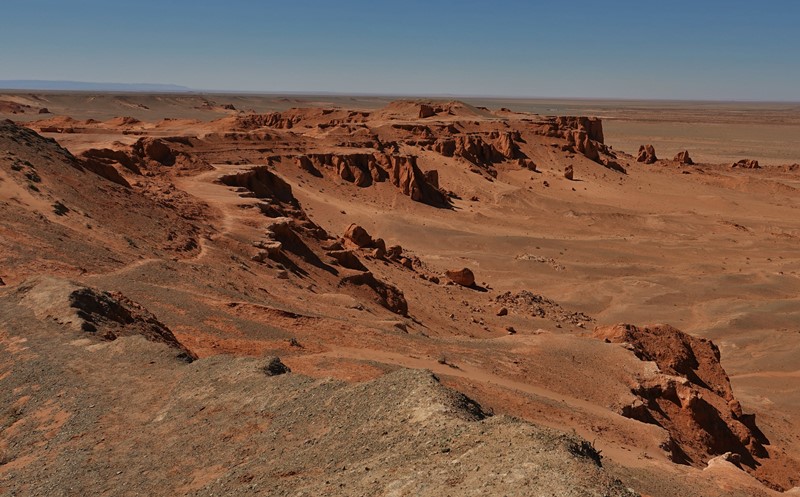 priceless paleontological finds. The first Velicoraptor was discovered here, the same goes for the species Oviraptor and Pinacosaurus of which specimens were first found at this famous Gobi location. Efforts are currently underway to bring information about the paleontological significance of Baynzag to a broader audience, with popular science publications in print and online[2].
priceless paleontological finds. The first Velicoraptor was discovered here, the same goes for the species Oviraptor and Pinacosaurus of which specimens were first found at this famous Gobi location. Efforts are currently underway to bring information about the paleontological significance of Baynzag to a broader audience, with popular science publications in print and online[2].
An interpretive visitor center is being planned, along with the designation of a “Baynzag Park” to protect the area. In Ulaanbaatar a new dinosaur museum, in the building of the former Lenin Museum, houses several displays of dinosaurs from the Gobi sites. Further to the Southwest in South Gobi province, the oasis of Zulganai and the canyons of Khermen Tsav are other typical desert landscapes.
We visited “Baynzag” on the last day, after the camel trekking, enroute back to Dalanzadgad, the provincial capital of South Gobi. The trek itself was through the Western Beauty Mountains, one of the “three beauties” after which “Gobi Gurvan Saikhan” – the “Three Beauties of the Gobi” National Park is named. The Western Beauty Mountains are rugged peaks, their valley bottoms with winding river beds of gravel along which bunches of high needle grasses grow.
Almond Blossoms in the Mongolian Gobi
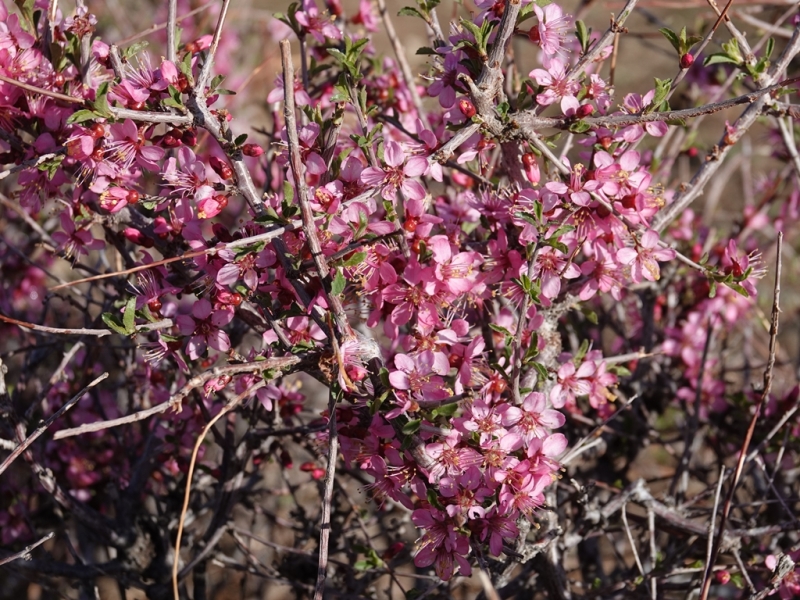
On the lower slopes of the valleys grow Mongolian almond bushes (Amygdales mongolica), or “Builsen” in the local language. Dark bushes during most of the year, they blossom in many shades of pink during spring time. May last year seemed a particular good time for these colorful displays. The mountain sides were dotted with the flowering bushes. On the last morning, after a spring snow fall during the night, the almond flowers near our campsite were a beautiful contrast against the backdrop of the mountains with the white dusting of snow. On the higher slopes of the Western Beauty Mountains dwarf juniper (Juniperus sabina) is common, creating the large green patches that are so typical for all of the park’s mountain ranges.
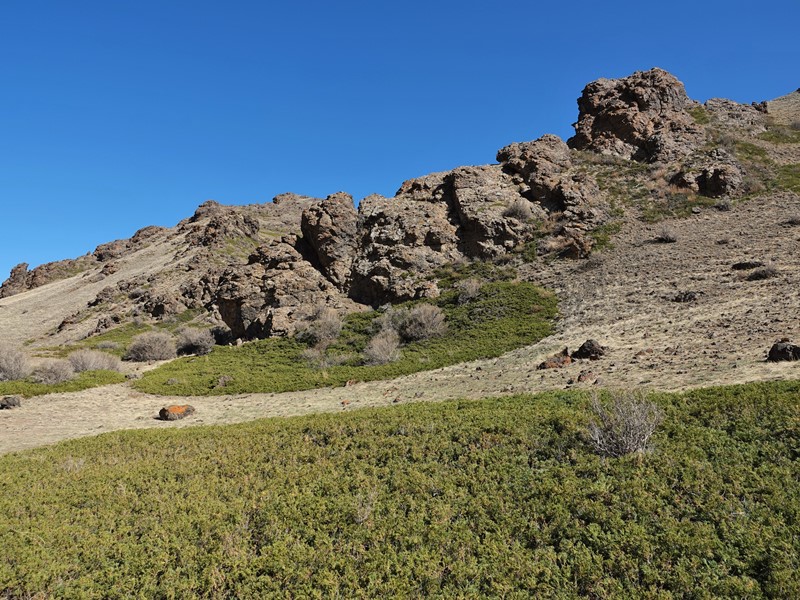
On day one of our camel trek, we left from a staging area in the plains, at the campsite of one of our camel guides, and where the other guide had traveled to with his camels. We had prepacked all our gear, including personal clothing and all camping equipment, in big duffel bags and our camp kitchen and provisions in the usual pannier bags that we also use for horse pack trips. With the camel guides’ experience and the help of our horseman who knows the routine with pack horses, loading the camels was an easy feat for our trekking crew, and we set off towards the mountains, with a stiff breeze blowing, under a gloomy sky of dust filled air.
Through the Western Beauty Mountains
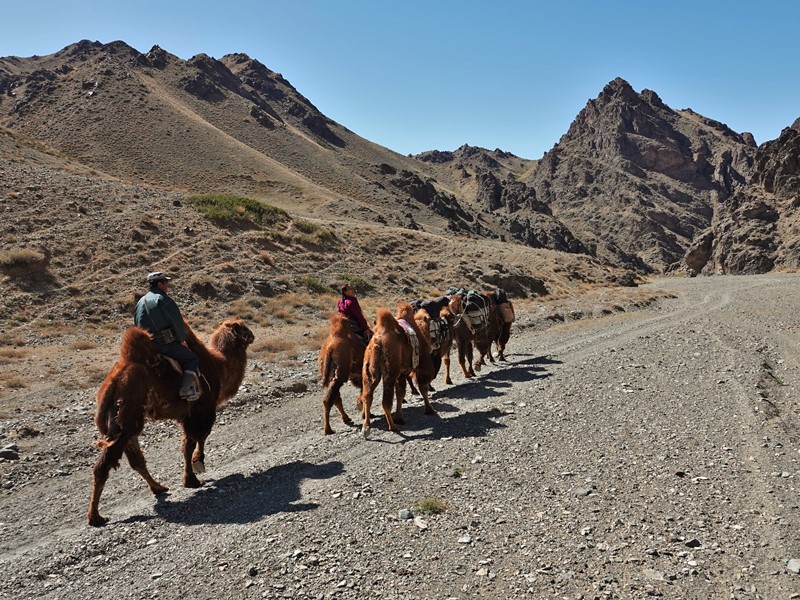
One of the highlights of our camel trekking in Mongolia’s Gobi was the ride into and through Gegetiin Am, a scenic gorge among high cliffs of dark rock and with a permanent creek running through. Having traversed the Western Beauty Mountains from North to South by crossing a moderate pass, our camel back approach to the spectacular gorge was from the South, entering from a high plain where yak and horses were grazing. The rock walls to both sides get gradually higher and the valley narrows, as one enters the gorge, until one rides close the walls of black rocks.
There is hardly a camp site in the entire gorge, except one meadow that is a bit elevated above the river bed and below a rocky slope. There was not sufficient and suitable grazing for our camels to here and the guides walked them back a ways so they had forage for the nights and the day we spent here. We camped two nights in the gorge, giving us opportunity for hikes and scrambles into the rugged hills and towers surrounding us. When the winds subsided, this was a peaceful place to spend a rest day, or to go explore. For springtime camel trekking in Mongolia’s Gobi camping in the gorge is an option, while in the summer time, with a greater chance of rainfalls with subsequent flooding through the canyon, whether to camp here must be considered with even greater care.
Exiting the gorge at the Northern side of the mountains was just as scenic as our entry from the South. Some of us walked a fair bit, leading our camels after they had been a bit weary of large light colored boulders on the valley bottom. Long ago broken off from the high cliffs above, these rocks were weathered and their shape was for our careful camels a bit too reminiscent of that of wolves. In this respect, our trusty camels displayed behavior we are well used to from Mongolian horses. They both live in environments where their natural predators occur, and it is a fact of life as a rider of these animals in these areas, that they live by the notion “Better safe than sorry”.
Trekking the Gobi – on Camel Back and Foot
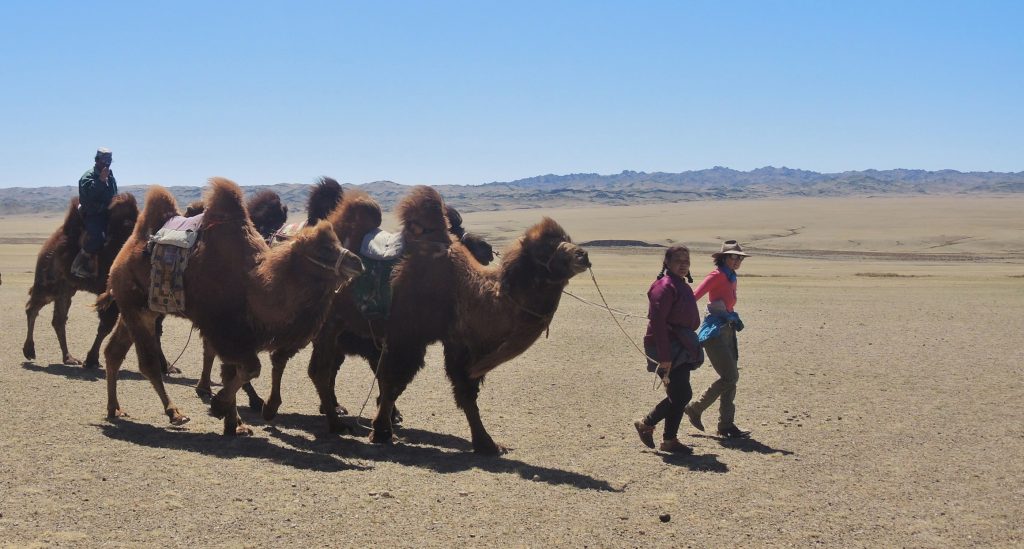
It is actually a nice aspect of camel trekking that one can get off and walk for a while without slowing down the caravan too much. Of course camels can move faster as well, and on shorter rides, without pack camels, we have done a fair bit of trotting across the desert this year. But in general, camel trekking in Mongolia’s Gobi is at a slower pace than a horse back expedition with riding and pack horses, and allows for trekking along on foot – be it to give the camel a break, to be safer when a camel becomes a bit weary of imagined predators, or just for the enjoyment of walking through a serene landscape.
Our spring time camel trekking in Mongolia’s Gobi turned out to be a great way to take in the landscape, and a more intimate experience than vehicle travel would provide you. Learning about camel behavior, and being so close to these creatures that are so well adapted to their desert environment, is a very interesting experience itself. And last not least, camel trekking inevitably brings you in close contact with members of the community of nomadic livestock herders who call the Gobi their home and share their knowledge of their unique culture and environment with those who venture to travel with them.
In their review on tripadvisor, our trekking guests summed it up as “a magical adventure and one that we will not forget”.
——————————————–
Contact us to plan your Camel Trekking Adventure in the Gobi!
As camels are nicest in winter, with a thick coat of warm wool, our scheduled Camel Treks are in winter time. Not in the very coldest period, but in November, early December, and in February just after Lunar New Year, when the country side celebrations of this important traditional holiday are still going on in the Gobi. Learn more..
If your primary interest is in visiting the iconic sites of the Mongolian Gobi, such as the Vulture Gorge (Yoliin Am), Flaming Cliffs (Baynzag), and Khongoryn Els (Singing Sands), check out our 6 Day Gobi Desert Tour.
If you chose a Gobi Desert Tour in March, you can make it an 8 Day Tour that includes a visit to the Camel Festival, which takes place annually on March 6 and 7 in South Gobi province. Our Gobi Desert Tours are all scheduled between our Horse Riding Expeditions in Gorkhi Terelj National Park and the Khentii Mountains. Many guests have chosen to combine a horseback ride in the forest steppe with a Gobi desert adventure.
For a 10 day adventure into the more remote areas of the Mongolian Gobi, visiting prehistoric and paleontological sites, a Buddhist Temple in the mountains, and spending more time in the amazing landscapes of the Gobi, hiking, camel riding and traveling by 4×4, consider our Gobi Crossing.
[1] https://en.climate-data.org/asia/mongolia/south-gobi/dalanzadgad-30038/
[2]https://mongoliandinosaurs.org/learn-more/mongolian-dinosaurs/


